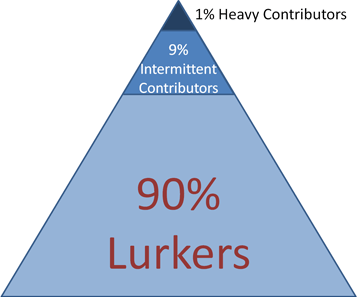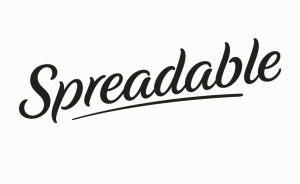Media spreads, sure. But what does this mean for users? What do they do?

http://www.nngroup.com/articles/participation-inequality/
How do people participate?
First, people lurk. Drawing from Jean Lave and Etiene Wenger, Jenkins, Ford, and Green, make the connection between new users within a community and those watching it from the sidelines to learn the rhetorical and social rules. It is through this activity, write Lave and Wenger, that “legitimate peripheral participation” happens and new comers are are able to first observe (lurk) and then more toward more active participants (158). They must first see what happens from the outside before they can be made part of the community.
Once inside, we “participate in something, that is, participation is organized in and through social collectives and connectivities” (163). In quoting Daniel Dayan, Jenkins, Ford, and Green, record: “A public is not simply a spectacular in plural, a sum of spectators, an addition. It is a coherent entity whose nature if collective; an ensemble characterized by shared sociability, shared identity and some sense of that identity” (2005, 46). We act within a social sphere through a performance that reenforces our social links and echoes our consensus beliefs. By becoming part of a community, we agree with their overlapping ideologies and act, to some degree, as part of that collective in the process.
To maintain these links, we act through three ‘C’s: curation, conversation, and circulation (171). We maintain collections of content as part of our community interactions. Be it part of utterances as embedded through a specific image shared or video played, we build a communal set of iconography that represents the thoughts of the community at the moment. And we talk about this content, creating or reenforcing social bonds through our conversation and discourse. By participating in a community, we become part of its information workflow: we maintain its imagery, embed its ideas, and circulate its feeds.
Jenkins, Ford, and Green place the community of users and their actions above their commercial value. Instead of being merely selling points, they see “that audience members are more than data, that their collective discussions and deliberations — and their active involvement in appraising and circulating content — are generative” (179). People, and their participation, are at the heart of the how spreadable media works: without the people, there are no social networks and no fertile soil for media content to thrive.
It is this empowering that raises participation into the fundamental source of understanding spreadable media. Write Jenkins, Ford, and Green, “In a world where everyday citizens may help select and circulate media content, playing active roles in building links between dispersed communities, there are new ways of working around the entrenched interests of traditional gatekeepers and in allegiance with others who may spread their content” (288). Instead of being based on the content or the ways it may be repressed, Spreadable Media holds an emphasis on the people and their actions — media is only spread through them!

Dan,
You highlighted my favorite aspect of this text: user agency. Throughout the text, I felt that the authors emphasized the need for media producers to acknowledge and accept the amount of agency that users have. Media producers believe that they make things “viral,” but the reality is that they are dependent on users/consumers to spread their information. This is empowering for users, and media producers are resistant to this empowerment. From a rhetorical perspective, I appreciated the focus on agency and the way in which consumers can move or spread media for specific purposes and aims outside of those originally intended by the producers. This makes for a complex rhetorical situation that I find really intriguing.